【1】RPC原理
首先看个图:
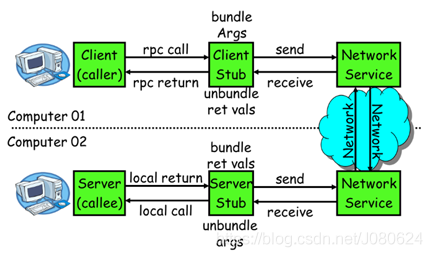
一次完整的RPC调用流程(同步调用,异步另说)如下:
1)服务消费方(client)调用以本地调用方式调用服务;
2)client stub(可以理解为代理)接收到调用后负责将方法、参数等组装成能够进行网络传输的消息体;
3)client stub找到服务地址,并将消息发送到服务端;
4)server stub收到消息后进行解码;
5)server stub根据解码结果调用本地的服务;
6)本地服务执行并将结果返回给server stub;
7)server stub将返回结果打包成消息并发送至消费方;
8)client stub接收到消息,并进行解码;
9)服务消费方得到最终结果。
RPC框架的目标就是要2~8这些步骤都封装起来,这些细节对用户来说是透明的,不可见的。
【2】Netty通信原理
Netty是一个异步事件驱动的网络应用程序框架, 用于快速开发可维护的高性能协议服务器和客户端。它极大地简化了TCP和UDP套接字服务器等网络编程。
① BIO:(Blocking IO)
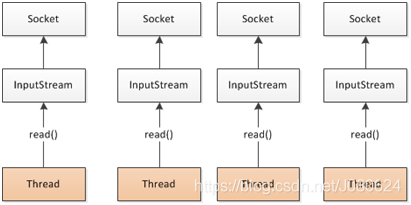
② NIO (Non-Blocking IO)
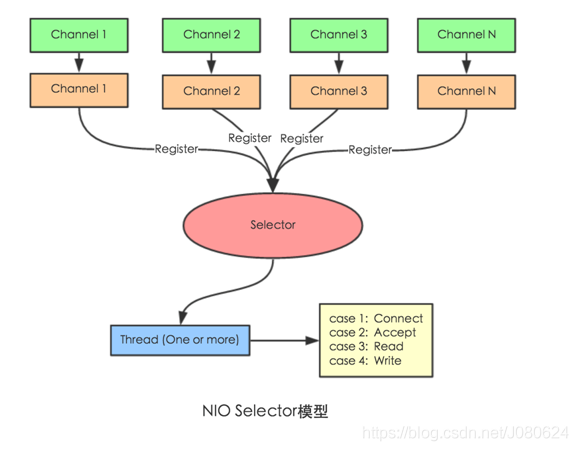
Selector 一般称 为选择器 ,也可以翻译为 多路复用器。
四种状态:Connect(连接就绪)、Accept(接受就绪)、Read(读就绪)、Write(写就绪)。
③ Netty基本原理
如下图所示:
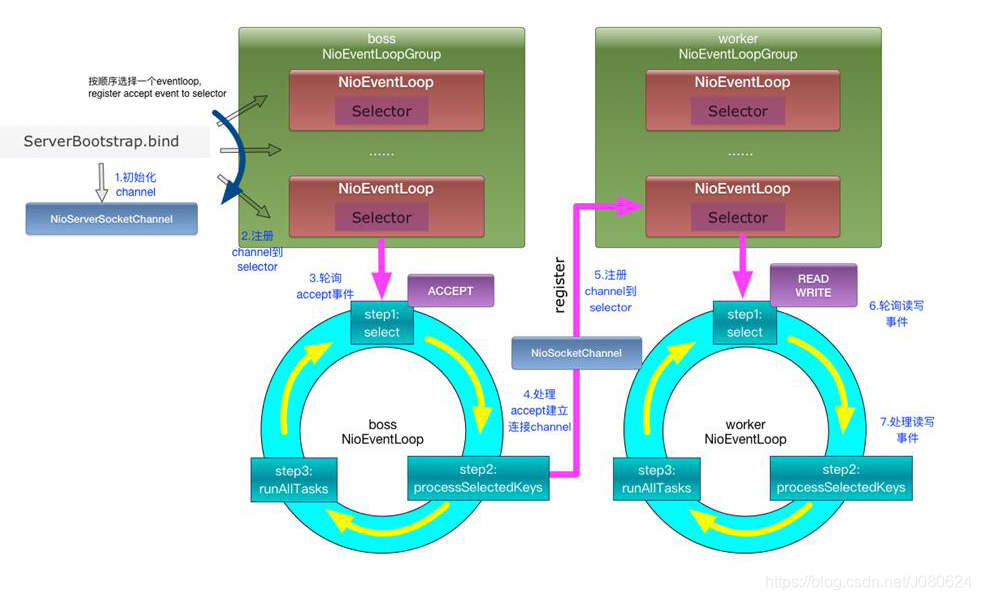
Netty下载和使用参考官网地址:https://netty.io/。
Netty基础入门学习参考博文:
【3】Dubbo的框架设计
更多详细内容参考官网地址,如下图所示:
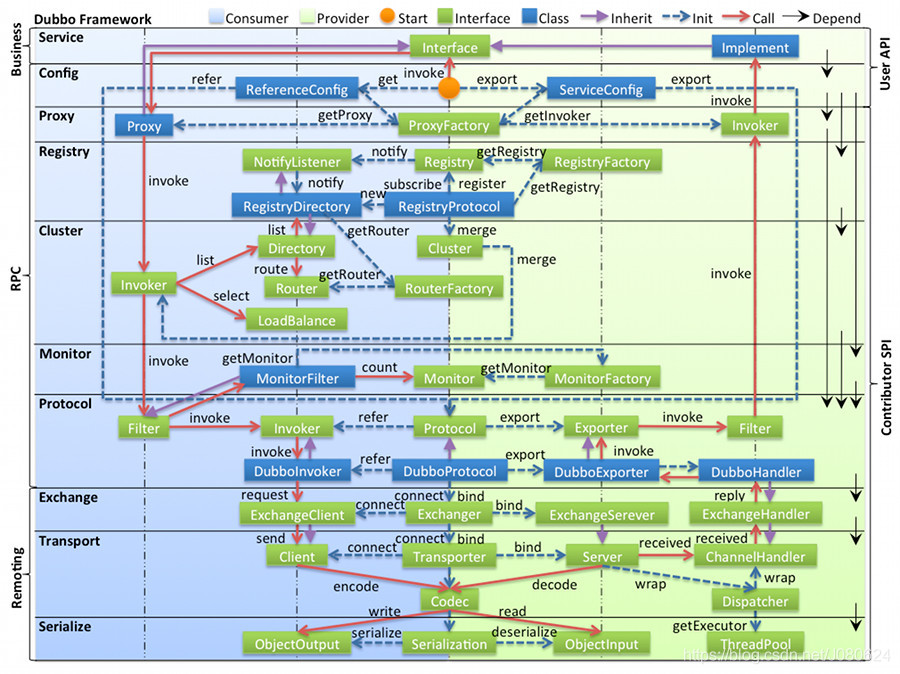
图例说明:
- 图中左边淡蓝背景的为服务消费方使用的接口,右边淡绿色背景的为服务提供方使用的接口,位于中轴线上的为双方都用到的接口。
- 图中从下至上分为十层,各层均为单向依赖,右边的黑色箭头代表层之间的依赖关系,每一层都可以剥离上层被复用,其中,Service 和 Config 层为 API,其它各层均为 SPI。
- 图中绿色小块的为扩展接口,蓝色小块为实现类,图中只显示用于关联各层的实现类。
- 图中蓝色虚线为初始化过程,即启动时组装链,红色实线为方法调用过程,即运行时调时链,紫色三角箭头为继承,可以把子类看作父类的同一个节点,线上的文字为调用的方法。
各层说明
- config 配置层:对外配置接口,以 ServiceConfig, ReferenceConfig 为中心,可以直接初始化配置类,也可以通过 spring 解析配置生成配置类
- proxy 服务代理层:服务接口透明代理,生成服务的客户端 Stub 和服务器端 Skeleton, 以 ServiceProxy 为中心,扩展接口为 ProxyFactory
- registry 注册中心层:封装服务地址的注册与发现,以服务 URL 为中心,扩展接口为 RegistryFactory, Registry, RegistryService
- cluster 路由层:封装多个提供者的路由及负载均衡,并桥接注册中心,以 Invoker 为中心,扩展接口为 Cluster, Directory, Router, LoadBalance
- monitor 监控层:RPC 调用次数和调用时间监控,以 Statistics 为中心,扩展接口为 MonitorFactory, Monitor, MonitorService
- protocol 远程调用层:封装 RPC 调用,以 Invocation, Result 为中心,扩展接口为 Protocol, Invoker, Exporter
- exchange 信息交换层:封装请求响应模式,同步转异步,以 Request, Response 为中心,扩展接口为 Exchanger, ExchangeChannel, ExchangeClient, ExchangeServer
- transport 网络传输层:抽象 mina 和 netty 为统一接口,以 Message 为中心,扩展接口为 Channel, Transporter, Client, Server, Codec
- serialize 数据序列化层:可复用的一些工具,扩展接口为 Serialization, ObjectInput, ObjectOutput, ThreadPool
关系说明
- 在 RPC 中,Protocol 是核心层,也就是只要有 Protocol + Invoker + Exporter 就可以完成非透明的 RPC 调用,然后在 Invoker 的主过程上 Filter 拦截点。
- 图中的 Consumer 和 Provider 是抽象概念,只是想让看图者更直观的了解哪些类分属于客户端与服务器端,不用 Client 和 Server 的原因是 Dubbo 在很多场景下都使用 Provider, Consumer, Registry, Monitor 划分逻辑拓普节点,保持统一概念。
- 而 Cluster 是外围概念,所以 Cluster 的目的是将多个 Invoker 伪装成一个 Invoker,这样其它人只要关注 Protocol 层 Invoker 即可,加上 Cluster 或者去掉 Cluster 对其它层都不会造成影响,因为只有一个提供者时,是不需要 Cluster 的。
- Proxy 层封装了所有接口的透明化代理,而在其它层都以 Invoker 为中心,只有到了暴露给用户使用时,才用 Proxy 将 Invoker 转成接口,或将接口实现转成 Invoker,也就是去掉 Proxy 层 RPC 是可以 Run 的,只是不那么透明,不那么看起来像调本地服务一样调远程服务。
- 而 Remoting 实现是 Dubbo 协议的实现,如果你选择 RMI 协议,整个 Remoting 都不会用上,Remoting 内部再划为 Transport 传输层和 Exchange 信息交换层,Transport 层只负责单向消息传输,是对 Mina, Netty, Grizzly 的抽象,它也可以扩展 UDP 传输,而 Exchange 层是在传输层之上封装了 Request-Response 语义。
- Registry 和 Monitor 实际上不算一层,而是一个独立的节点,只是为了全局概览,用层的方式画在一起。
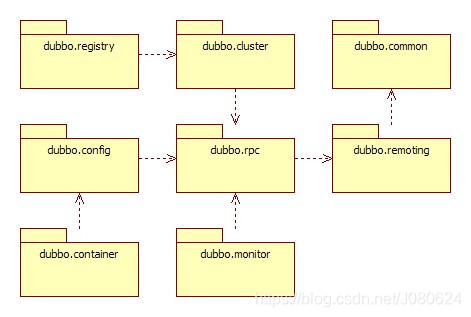
模块说明:
- dubbo-common 公共逻辑模块:包括 Util 类和通用模型。
- dubbo-remoting 远程通讯模块:相当于 Dubbo 协议的实现,如果 RPC 用 RMI协议则不需要使用此包。
- dubbo-rpc 远程调用模块:抽象各种协议,以及动态代理,只包含一对一的调用,不关心集群的管理。
- dubbo-cluster 集群模块:将多个服务提供方伪装为一个提供方,包括:负载均衡, 容错,路由等,集群的地址列表可以是静态配置的,也可以是由注册中心下发。
- dubbo-registry 注册中心模块:基于注册中心下发地址的集群方式,以及对各种注册中心的抽象。
- dubbo-monitor 监控模块:统计服务调用次数,调用时间的,调用链跟踪的服务。
- dubbo-config 配置模块:是 Dubbo 对外的 API,用户通过 Config 使用D ubbo,隐藏 Dubbo 所有细节。
- dubbo-container 容器模块:是一个 Standlone 的容器,以简单的 Main 加载 Spring 启动,因为服务通常不需要 Tomcat/JBoss 等 Web 容器的特性,没必要用 Web 容器去加载服务。
整体上按照分层结构进行分包,与分层的不同点在于:
- container 为服务容器,用于部署运行服务,没有在层中画出。
- protocol 层和 proxy 层都放在 rpc 模块中,这两层是 rpc 的核心,在不需要集群也就是只有一个提供者时,可以只使用这两层完成 rpc 调用。
- transport 层和 exchange 层都放在 remoting 模块中,为 rpc 调用的通讯基础。
- serialize 层放在 common 模块中,以便更大程度复用。
依赖关系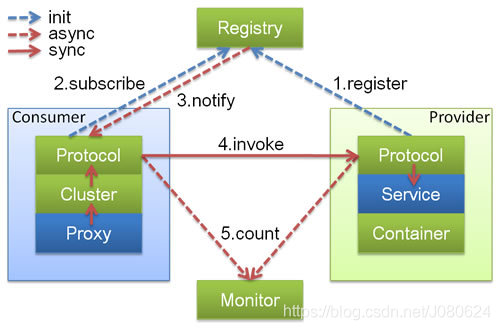
- 图中小方块 Protocol, Cluster, Proxy, Service, Container, Registry, Monitor 代表层或模块,蓝色的表示与业务有交互,绿色的表示只对 Dubbo 内部交互。
- 图中背景方块 Consumer, Provider, Registry, Monitor 代表部署逻辑拓扑节点。
- 图中蓝色虚线为初始化时调用,红色虚线为运行时异步调用,红色实线为运行时同步调用。
- 图中只包含 RPC 的层,不包含 Remoting 的层,Remoting 整体都隐含在 Protocol 中。
【4】解析标签并加载配置
如下所示,我们在spring的xml中配置了dubbo标签:
<dubbo:application name="order-service-consumer"></dubbo:application>
<dubbo:registry address="zookeeper://127.0.0.1:2181"></dubbo:registry>那么Dubbo是如何拿到配置信息呢?这就又要提到一个重要接口BeanDefinitionParser!
如下图所示,该接口有诸多实现类为项目提供支持:
如AnnotationConfigBeanDefinitionParser是解析<context:annotation-config/>标签的,org.springframework.web.servlet.config.AnnotationDrivenBeanDefinitionParser是解析<mvc:annotation-driven/>标签的,ComponentScanBeanDefinitionParser是解析<context:component-scan/>标签的(参考三个标签使用详解)。同样这里DubboBeanDefinitionParser就是为Dubbo标签提供支持的。
该类整体结构如下所示,其中parse方法是解析标签的核心:
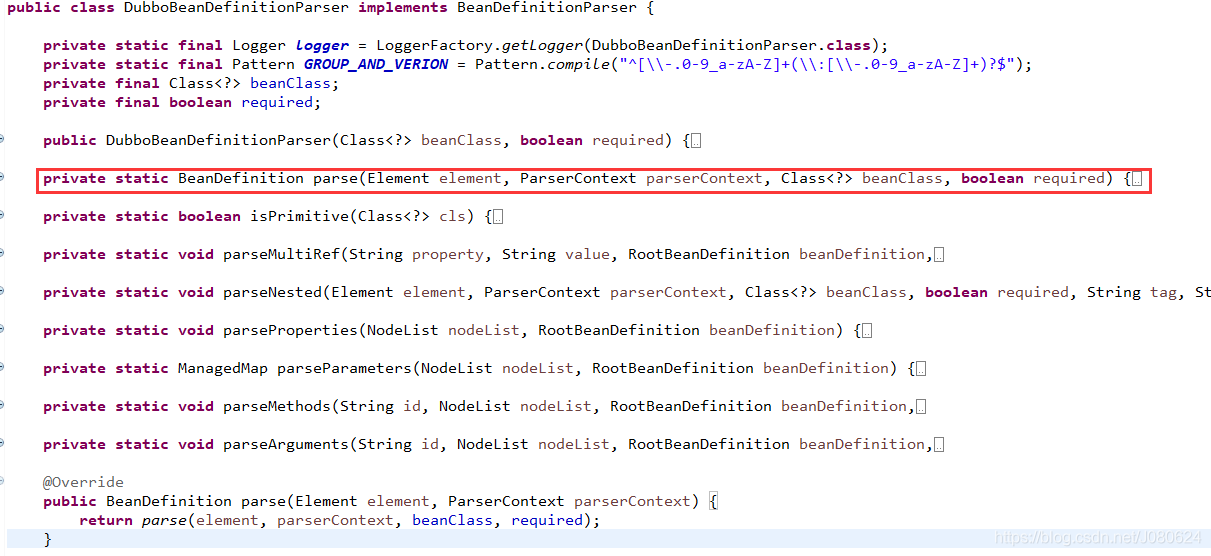
在parse方法中,每次标签解析都对应一个beanClass,如MethodConfig。这个类从哪里来,需要查看DubboNamespaceHandler。
其源码如下:
public class DubboNamespaceHandler extends NamespaceHandlerSupport {
static {
Version.checkDuplicate(DubboNamespaceHandler.class);
}
@Override
public void init() {
registerBeanDefinitionParser("application", new DubboBeanDefinitionParser(ApplicationConfig.class, true));
registerBeanDefinitionParser("module", new DubboBeanDefinitionParser(ModuleConfig.class, true));
registerBeanDefinitionParser("registry", new DubboBeanDefinitionParser(RegistryConfig.class, true));
registerBeanDefinitionParser("monitor", new DubboBeanDefinitionParser(MonitorConfig.class, true));
registerBeanDefinitionParser("provider", new DubboBeanDefinitionParser(ProviderConfig.class, true));
registerBeanDefinitionParser("consumer", new DubboBeanDefinitionParser(ConsumerConfig.class, true));
registerBeanDefinitionParser("protocol", new DubboBeanDefinitionParser(ProtocolConfig.class, true));
registerBeanDefinitionParser("service", new DubboBeanDefinitionParser(ServiceBean.class, true));
registerBeanDefinitionParser("reference", new DubboBeanDefinitionParser(ReferenceBean.class, false));
registerBeanDefinitionParser("annotation", new AnnotationBeanDefinitionParser());
}
}可以发现在启init()方法中,注册了一系列beanClass不同的DubboBeanDefinitionParser。
其实解析标签过程就是将每个标签的具体设置信息保存到每个标签对应的beanClass对应的对象中,如MethodConfig。
不过这里需要注意几个特殊的地方,ServiceBean、ReferenceBean和AnnotationBeanDefinitionParser。并不再是XXXConfig。尤其是ServiceBean涉及到服务暴露,ReferenceBean涉及到服务引用。
【5】Dubbo中的服务暴露
首先看一下ServiceBean的源码:
public class ServiceBean<T> extends ServiceConfig<T> implements InitializingBean,
DisposableBean, ApplicationContextAware, ApplicationListener<ContextRefreshedEvent>,
BeanNameAware {
//...
}其实现的InitializingBean是在对象属性设置完之后进行操作,DisposableBean是在对象销毁前进行操作(这两个Bean不熟悉的可以参考本篇博客),ApplicationContextAware用来获取应用上下文。尤其需要需要的是其实现了ApplicationListener<ContextRefreshedEvent>,会在容器初始化之后调用其onApplicationEvent()方法(参考本篇博客)。
也就是说,在ServiceBean对象创建并设置属性后,会调用afterPropertiesSet()方法;在Spring容器初始化后会调用onApplicationEvent()方法。
① afterPropertiesSet()方法如下:
public void afterPropertiesSet() throws Exception {
if (getProvider() == null) {
Map<String, ProviderConfig> providerConfigMap = applicationContext == null ? null : BeanFactoryUtils.beansOfTypeIncludingAncestors(applicationContext, ProviderConfig.class, false, false);
if (providerConfigMap != null && providerConfigMap.size() > 0) {
Map<String, ProtocolConfig> protocolConfigMap = applicationContext == null ? null : BeanFactoryUtils.beansOfTypeIncludingAncestors(applicationContext, ProtocolConfig.class, false, false);
if ((protocolConfigMap == null || protocolConfigMap.size() == 0)
&& providerConfigMap.size() > 1) { // backward compatibility
List<ProviderConfig> providerConfigs = new ArrayList<ProviderConfig>();
for (ProviderConfig config : providerConfigMap.values()) {
if (config.isDefault() != null && config.isDefault().booleanValue()) {
providerConfigs.add(config);
}
}
if (!providerConfigs.isEmpty()) {
setProviders(providerConfigs);
}
} else {
ProviderConfig providerConfig = null;
for (ProviderConfig config : providerConfigMap.values()) {
if (config.isDefault() == null || config.isDefault().booleanValue()) {
if (providerConfig != null) {
throw new IllegalStateException("Duplicate provider configs: " + providerConfig + " and " + config);
}
providerConfig = config;
}
}
if (providerConfig != null) {
setProvider(providerConfig);
}
}
}
}
if (getApplication() == null
&& (getProvider() == null || getProvider().getApplication() == null)) {
Map<String, ApplicationConfig> applicationConfigMap = applicationContext == null ? null : BeanFactoryUtils.beansOfTypeIncludingAncestors(applicationContext, ApplicationConfig.class, false, false);
if (applicationConfigMap != null && applicationConfigMap.size() > 0) {
ApplicationConfig applicationConfig = null;
for (ApplicationConfig config : applicationConfigMap.values()) {
if (config.isDefault() == null || config.isDefault().booleanValue()) {
if (applicationConfig != null) {
throw new IllegalStateException("Duplicate application configs: " + applicationConfig + " and " + config);
}
applicationConfig = config;
}
}
if (applicationConfig != null) {
setApplication(applicationConfig);
}
}
}
if (getModule() == null
&& (getProvider() == null || getProvider().getModule() == null)) {
Map<String, ModuleConfig> moduleConfigMap = applicationContext == null ? null : BeanFactoryUtils.beansOfTypeIncludingAncestors(applicationContext, ModuleConfig.class, false, false);
if (moduleConfigMap != null && moduleConfigMap.size() > 0) {
ModuleConfig moduleConfig = null;
for (ModuleConfig config : moduleConfigMap.values()) {
if (config.isDefault() == null || config.isDefault().booleanValue()) {
if (moduleConfig != null) {
throw new IllegalStateException("Duplicate module configs: " + moduleConfig + " and " + config);
}
moduleConfig = config;
}
}
if (moduleConfig != null) {
setModule(moduleConfig);
}
}
}
if ((getRegistries() == null || getRegistries().isEmpty())
&& (getProvider() == null || getProvider().getRegistries() == null || getProvider().getRegistries().isEmpty())
&& (getApplication() == null || getApplication().getRegistries() == null || getApplication().getRegistries().isEmpty())) {
Map<String, RegistryConfig> registryConfigMap = applicationContext == null ? null : BeanFactoryUtils.beansOfTypeIncludingAncestors(applicationContext, RegistryConfig.class, false, false);
if (registryConfigMap != null && registryConfigMap.size() > 0) {
List<RegistryConfig> registryConfigs = new ArrayList<RegistryConfig>();
for (RegistryConfig config : registryConfigMap.values()) {
if (config.isDefault() == null || config.isDefault().booleanValue()) {
registryConfigs.add(config);
}
}
if (registryConfigs != null && !registryConfigs.isEmpty()) {
super.setRegistries(registryConfigs);
}
}
}
if (getMonitor() == null
&& (getProvider() == null || getProvider().getMonitor() == null)
&& (getApplication() == null || getApplication().getMonitor() == null)) {
Map<String, MonitorConfig> monitorConfigMap = applicationContext == null ? null : BeanFactoryUtils.beansOfTypeIncludingAncestors(applicationContext, MonitorConfig.class, false, false);
if (monitorConfigMap != null && monitorConfigMap.size() > 0) {
MonitorConfig monitorConfig = null;
for (MonitorConfig config : monitorConfigMap.values()) {
if (config.isDefault() == null || config.isDefault().booleanValue()) {
if (monitorConfig != null) {
throw new IllegalStateException("Duplicate monitor configs: " + monitorConfig + " and " + config);
}
monitorConfig = config;
}
}
if (monitorConfig != null) {
setMonitor(monitorConfig);
}
}
}
if ((getProtocols() == null || getProtocols().isEmpty())
&& (getProvider() == null || getProvider().getProtocols() == null || getProvider().getProtocols().isEmpty())) {
Map<String, ProtocolConfig> protocolConfigMap = applicationContext == null ? null : BeanFactoryUtils.beansOfTypeIncludingAncestors(applicationContext, ProtocolConfig.class, false, false);
if (protocolConfigMap != null && protocolConfigMap.size() > 0) {
List<ProtocolConfig> protocolConfigs = new ArrayList<ProtocolConfig>();
for (ProtocolConfig config : protocolConfigMap.values()) {
if (config.isDefault() == null || config.isDefault().booleanValue()) {
protocolConfigs.add(config);
}
}
if (protocolConfigs != null && !protocolConfigs.isEmpty()) {
super.setProtocols(protocolConfigs);
}
}
}
if (getPath() == null || getPath().length() == 0) {
if (beanName != null && beanName.length() > 0
&& getInterface() != null && getInterface().length() > 0
&& beanName.startsWith(getInterface())) {
setPath(beanName);
}
}
if (!isDelay()) {
export();
}
}这个方法做了什么呢?可以看到里面有很多诸如setProvider(providerConfig);,setApplication(applicationConfig);, setModule(moduleConfig);等语句,就是将获取到的配置信息保存在ServiceBean中。
方法末尾会判断是否延迟,否则将会调用export()方法暴露服务:
if (!isDelay()) {
export();
}② onApplicationEvent方法如下:
public void onApplicationEvent(ContextRefreshedEvent event) {
if (isDelay() && !isExported() && !isUnexported()) {
if (logger.isInfoEnabled()) {
logger.info("The service ready on spring started. service: " + getInterface());
}
export();
}
}判断如果是延迟的&没有被暴露&应该被暴露的,就会调用 export();方法暴露服务。
③ export()方法源码如下:
public synchronized void export() {
if (provider != null) {
if (export == null) {
export = provider.getExport();
}
if (delay == null) {
delay = provider.getDelay();
}
}
if (export != null && !export) {
return;
}
//前面都是获取、判断操作,下面才是关键
if (delay != null && delay > 0) {
delayExportExecutor.schedule(new Runnable() {
@Override
public void run() {
doExport();
}
}, delay, TimeUnit.MILLISECONDS);
} else {
doExport();
}
}④ doExport()方法源码如下:
protected synchronized void doExport() {
if (unexported) {
throw new IllegalStateException("Already unexported!");
}
if (exported) {
return;
}
exported = true;
if (interfaceName == null || interfaceName.length() == 0) {
throw new IllegalStateException("<dubbo:service interface=\"\" /> interface not allow null!");
}
checkDefault();
if (provider != null) {
if (application == null) {
application = provider.getApplication();
}
if (module == null) {
module = provider.getModule();
}
if (registries == null) {
registries = provider.getRegistries();
}
if (monitor == null) {
monitor = provider.getMonitor();
}
if (protocols == null) {
protocols = provider.getProtocols();
}
}
if (module != null) {
if (registries == null) {
registries = module.getRegistries();
}
if (monitor == null) {
monitor = module.getMonitor();
}
}
if (application != null) {
if (registries == null) {
registries = application.getRegistries();
}
if (monitor == null) {
monitor = application.getMonitor();
}
}
if (ref instanceof GenericService) {
interfaceClass = GenericService.class;
if (StringUtils.isEmpty(generic)) {
generic = Boolean.TRUE.toString();
}
} else {
try {
interfaceClass = Class.forName(interfaceName, true, Thread.currentThread()
.getContextClassLoader());
} catch (ClassNotFoundException e) {
throw new IllegalStateException(e.getMessage(), e);
}
checkInterfaceAndMethods(interfaceClass, methods);
checkRef();
generic = Boolean.FALSE.toString();
}
if (local != null) {
//本地代理
if ("true".equals(local)) {
local = interfaceName + "Local";
}
Class<?> localClass;
try {
localClass = ClassHelper.forNameWithThreadContextClassLoader(local);
} catch (ClassNotFoundException e) {
throw new IllegalStateException(e.getMessage(), e);
}
if (!interfaceClass.isAssignableFrom(localClass)) {
throw new IllegalStateException("The local implementation class " + localClass.getName() + " not implement interface " + interfaceName);
}
}
if (stub != null) {
//本地助手
if ("true".equals(stub)) {
stub = interfaceName + "Stub";
}
Class<?> stubClass;
try {
stubClass = ClassHelper.forNameWithThreadContextClassLoader(stub);
} catch (ClassNotFoundException e) {
throw new IllegalStateException(e.getMessage(), e);
}
if (!interfaceClass.isAssignableFrom(stubClass)) {
throw new IllegalStateException("The stub implementation class " + stubClass.getName() + " not implement interface " + interfaceName);
}
}
checkApplication();
checkRegistry();
checkProtocol();
appendProperties(this);
checkStubAndMock(interfaceClass);
if (path == null || path.length() == 0) {
path = interfaceName;
}
//这里是关键
doExportUrls();
ProviderModel providerModel = new ProviderModel(getUniqueServiceName(), this, ref);
ApplicationModel.initProviderModel(getUniqueServiceName(), providerModel);
}⑤ doExportUrls方法源码如下:
@SuppressWarnings({"unchecked", "rawtypes"})
private void doExportUrls() {
//加载注册中心的信息
List<URL> registryURLs = loadRegistries(true);
//在某个端口使用某种协议暴露,如dubbo 20882
for (ProtocolConfig protocolConfig : protocols) {
doExportUrlsFor1Protocol(protocolConfig, registryURLs);
}
}核心方法为doExportUrlsFor1Protocol,服务暴露就是在该方法中完成的。
⑥ doExportUrlsFor1Protocol
private void doExportUrlsFor1Protocol(ProtocolConfig protocolConfig, List<URL> registryURLs) {
//这里省略诸多代码
//...
// export service
String contextPath = protocolConfig.getContextpath();
if ((contextPath == null || contextPath.length() == 0) && provider != null) {
contextPath = provider.getContextpath();
}
String host = this.findConfigedHosts(protocolConfig, registryURLs, map);
Integer port = this.findConfigedPorts(protocolConfig, name, map);
URL url = new URL(name, host, port, (contextPath == null || contextPath.length() == 0 ? "" : contextPath + "/") + path, map);
if (ExtensionLoader.getExtensionLoader(ConfiguratorFactory.class)
.hasExtension(url.getProtocol())) {
url = ExtensionLoader.getExtensionLoader(ConfiguratorFactory.class)
.getExtension(url.getProtocol()).getConfigurator(url).configure(url);
}
String scope = url.getParameter(Constants.SCOPE_KEY);
// don't export when none is configured
if (!Constants.SCOPE_NONE.toString().equalsIgnoreCase(scope)) {
// export to local if the config is not remote (export to remote only when config is remote)
if (!Constants.SCOPE_REMOTE.toString().equalsIgnoreCase(scope)) {
exportLocal(url);
}
// export to remote if the config is not local (export to local only when config is local)
if (!Constants.SCOPE_LOCAL.toString().equalsIgnoreCase(scope)) {
if (logger.isInfoEnabled()) {
logger.info("Export dubbo service " + interfaceClass.getName() + " to url " + url);
}
if (registryURLs != null && !registryURLs.isEmpty()) {
for (URL registryURL : registryURLs) {
url = url.addParameterIfAbsent(Constants.DYNAMIC_KEY, registryURL.getParameter(Constants.DYNAMIC_KEY));
URL monitorUrl = loadMonitor(registryURL);
if (monitorUrl != null) {
url = url.addParameterAndEncoded(Constants.MONITOR_KEY, monitorUrl.toFullString());
}
if (logger.isInfoEnabled()) {
logger.info("Register dubbo service " + interfaceClass.getName() + " url " + url + " to registry " + registryURL);
}
// 这里,通过proxyFactory拿到Invoker
Invoker<?> invoker = proxyFactory.getInvoker(ref, (Class) interfaceClass, registryURL.addParameterAndEncoded(Constants.EXPORT_KEY, url.toFullString()));
//对invoker进行了包装
DelegateProviderMetaDataInvoker wrapperInvoker = new DelegateProviderMetaDataInvoker(invoker, this);
//核心方法
Exporter<?> exporter = protocol.export(wrapperInvoker);
exporters.add(exporter);
}
} else {
Invoker<?> invoker = proxyFactory.getInvoker(ref, (Class) interfaceClass, url);
DelegateProviderMetaDataInvoker wrapperInvoker = new DelegateProviderMetaDataInvoker(invoker, this);
Exporter<?> exporter = protocol.export(wrapperInvoker);
exporters.add(exporter);
}
}
}
this.urls.add(url);
}该方法中核心语句 Exporter<?> exporter = protocol.export(wrapperInvoker);进行远程服务暴露。其会先执行RegistryProtocol的<T> Exporter<T> export(final Invoker<T> originInvoker)方法,再执行DubboProtocol的<T> Exporter<T> export(Invoker<T> invoker)方法。
RegistryProtocol的<T> Exporter<T> export(final Invoker<T> originInvoker)方法如下所示:
@Override
public <T> Exporter<T> export(final Invoker<T> originInvoker) throws RpcException {
//export invoker 暴露服务
final ExporterChangeableWrapper<T> exporter = doLocalExport(originInvoker);
URL registryUrl = getRegistryUrl(originInvoker);
//registry provider
final Registry registry = getRegistry(originInvoker);
final URL registedProviderUrl = getRegistedProviderUrl(originInvoker);
//to judge to delay publish whether or not
boolean register = registedProviderUrl.getParameter("register", true);
//注册表注册provider--没错在另外方法将会注册消费者
ProviderConsumerRegTable.registerProvider(originInvoker, registryUrl, registedProviderUrl);
if (register) {
register(registryUrl, registedProviderUrl);
ProviderConsumerRegTable.getProviderWrapper(originInvoker).setReg(true);
}
// Subscribe the override data
// FIXME When the provider subscribes, it will affect the scene : a certain JVM exposes the service and call the same service. Because the subscribed is cached key with the name of the service, it causes the subscription information to cover.
final URL overrideSubscribeUrl = getSubscribedOverrideUrl(registedProviderUrl);
final OverrideListener overrideSubscribeListener = new OverrideListener(overrideSubscribeUrl, originInvoker);
overrideListeners.put(overrideSubscribeUrl, overrideSubscribeListener);
registry.subscribe(overrideSubscribeUrl, overrideSubscribeListener);
//Ensure that a new exporter instance is returned every time export
return new DestroyableExporter<T>(exporter, originInvoker, overrideSubscribeUrl, registedProviderUrl);
}⑦ DubboProtocol的<T> Exporter<T> export(Invoker<T> invoker)方法源码如下:
public <T> Exporter<T> export(Invoker<T> invoker) throws RpcException {
URL url = invoker.getUrl();
// export service.
String key = serviceKey(url);
DubboExporter<T> exporter = new DubboExporter<T>(invoker, key, exporterMap);
exporterMap.put(key, exporter);
//export an stub service for dispatching event
Boolean isStubSupportEvent = url.getParameter(Constants.STUB_EVENT_KEY, Constants.DEFAULT_STUB_EVENT);
Boolean isCallbackservice = url.getParameter(Constants.IS_CALLBACK_SERVICE, false);
if (isStubSupportEvent && !isCallbackservice) {
String stubServiceMethods = url.getParameter(Constants.STUB_EVENT_METHODS_KEY);
if (stubServiceMethods == null || stubServiceMethods.length() == 0) {
if (logger.isWarnEnabled()) {
logger.warn(new IllegalStateException("consumer [" + url.getParameter(Constants.INTERFACE_KEY) +
"], has set stubproxy support event ,but no stub methods founded."));
}
} else {
stubServiceMethodsMap.put(url.getServiceKey(), stubServiceMethods);
}
}
//这里是关键,启动Netty服务器,监听dubbo端口,如20882
openServer(url);
optimizeSerialization(url);
return exporter;
}⑧ 完整示意图如下:
⑨ 时序图
【6】Dubbo中的服务引用
ReferenceBean源码如下:
public class ReferenceBean<T> extends ReferenceConfig<T> implements FactoryBean, ApplicationContextAware, InitializingBean, DisposableBean {
//...
}其同样实现了ApplicationContextAware, InitializingBean, DisposableBean之外,还实现了FactoryBean(参考本篇博文)。所以说,获取ReferenceBean实例就需要调用其getObject()方法。
① getObject()
@Override
public Object getObject() throws Exception {
return get();
}而get()方法如下:
public synchronized T get() {
if (destroyed) {
throw new IllegalStateException("Already destroyed!");
}
if (ref == null) {
//这里是关键
init();
}
return ref;
}② init()
private void init() {
if (initialized) {
return;
}
initialized = true;
if (interfaceName == null || interfaceName.length() == 0) {
throw new IllegalStateException("<dubbo:reference interface=\"\" /> interface not allow null!");
}
// get consumer's global configuration
checkDefault();
appendProperties(this);
if (getGeneric() == null && getConsumer() != null) {
setGeneric(getConsumer().getGeneric());
}
if (ProtocolUtils.isGeneric(getGeneric())) {
interfaceClass = GenericService.class;
} else {
try {
interfaceClass = Class.forName(interfaceName, true, Thread.currentThread()
.getContextClassLoader());
} catch (ClassNotFoundException e) {
throw new IllegalStateException(e.getMessage(), e);
}
checkInterfaceAndMethods(interfaceClass, methods);
}
String resolve = System.getProperty(interfaceName);
String resolveFile = null;
if (resolve == null || resolve.length() == 0) {
resolveFile = System.getProperty("dubbo.resolve.file");
if (resolveFile == null || resolveFile.length() == 0) {
File userResolveFile = new File(new File(System.getProperty("user.home")), "dubbo-resolve.properties");
if (userResolveFile.exists()) {
resolveFile = userResolveFile.getAbsolutePath();
}
}
if (resolveFile != null && resolveFile.length() > 0) {
Properties properties = new Properties();
FileInputStream fis = null;
try {
fis = new FileInputStream(new File(resolveFile));
properties.load(fis);
} catch (IOException e) {
throw new IllegalStateException("Unload " + resolveFile + ", cause: " + e.getMessage(), e);
} finally {
try {
if (null != fis) fis.close();
} catch (IOException e) {
logger.warn(e.getMessage(), e);
}
}
resolve = properties.getProperty(interfaceName);
}
}
if (resolve != null && resolve.length() > 0) {
url = resolve;
if (logger.isWarnEnabled()) {
if (resolveFile != null && resolveFile.length() > 0) {
logger.warn("Using default dubbo resolve file " + resolveFile + " replace " + interfaceName + "" + resolve + " to p2p invoke remote service.");
} else {
logger.warn("Using -D" + interfaceName + "=" + resolve + " to p2p invoke remote service.");
}
}
}
if (consumer != null) {
if (application == null) {
application = consumer.getApplication();
}
if (module == null) {
module = consumer.getModule();
}
if (registries == null) {
registries = consumer.getRegistries();
}
if (monitor == null) {
monitor = consumer.getMonitor();
}
}
if (module != null) {
if (registries == null) {
registries = module.getRegistries();
}
if (monitor == null) {
monitor = module.getMonitor();
}
}
if (application != null) {
if (registries == null) {
registries = application.getRegistries();
}
if (monitor == null) {
monitor = application.getMonitor();
}
}
checkApplication();
checkStubAndMock(interfaceClass);
Map<String, String> map = new HashMap<String, String>();
Map<Object, Object> attributes = new HashMap<Object, Object>();
map.put(Constants.SIDE_KEY, Constants.CONSUMER_SIDE);
map.put(Constants.DUBBO_VERSION_KEY, Version.getVersion());
map.put(Constants.TIMESTAMP_KEY, String.valueOf(System.currentTimeMillis()));
if (ConfigUtils.getPid() > 0) {
map.put(Constants.PID_KEY, String.valueOf(ConfigUtils.getPid()));
}
if (!isGeneric()) {
String revision = Version.getVersion(interfaceClass, version);
if (revision != null && revision.length() > 0) {
map.put("revision", revision);
}
String[] methods = Wrapper.getWrapper(interfaceClass).getMethodNames();
if (methods.length == 0) {
logger.warn("NO method found in service interface " + interfaceClass.getName());
map.put("methods", Constants.ANY_VALUE);
} else {
map.put("methods", StringUtils.join(new HashSet<String>(Arrays.asList(methods)), ","));
}
}
map.put(Constants.INTERFACE_KEY, interfaceName);
appendParameters(map, application);
appendParameters(map, module);
appendParameters(map, consumer, Constants.DEFAULT_KEY);
appendParameters(map, this);
String prefix = StringUtils.getServiceKey(map);
if (methods != null && !methods.isEmpty()) {
for (MethodConfig method : methods) {
appendParameters(map, method, method.getName());
String retryKey = method.getName() + ".retry";
if (map.containsKey(retryKey)) {
String retryValue = map.remove(retryKey);
if ("false".equals(retryValue)) {
map.put(method.getName() + ".retries", "0");
}
}
appendAttributes(attributes, method, prefix + "." + method.getName());
checkAndConvertImplicitConfig(method, map, attributes);
}
}
String hostToRegistry = ConfigUtils.getSystemProperty(Constants.DUBBO_IP_TO_REGISTRY);
if (hostToRegistry == null || hostToRegistry.length() == 0) {
hostToRegistry = NetUtils.getLocalHost();
} else if (isInvalidLocalHost(hostToRegistry)) {
throw new IllegalArgumentException("Specified invalid registry ip from property:" + Constants.DUBBO_IP_TO_REGISTRY + ", value:" + hostToRegistry);
}
map.put(Constants.REGISTER_IP_KEY, hostToRegistry);
//attributes are stored by system context.
StaticContext.getSystemContext().putAll(attributes);
// 这里是关键! 创建代理!
ref = createProxy(map);
ConsumerModel consumerModel = new ConsumerModel(getUniqueServiceName(), this, ref, interfaceClass.getMethods());
ApplicationModel.initConsumerModel(getUniqueServiceName(), consumerModel);
}③ createProxy()
private T createProxy(Map<String, String> map) {
URL tmpUrl = new URL("temp", "localhost", 0, map);
final boolean isJvmRefer;
if (isInjvm() == null) {
if (url != null && url.length() > 0) { // if a url is specified, don't do local reference
isJvmRefer = false;
} else if (InjvmProtocol.getInjvmProtocol().isInjvmRefer(tmpUrl)) {
// by default, reference local service if there is
isJvmRefer = true;
} else {
isJvmRefer = false;
}
} else {
isJvmRefer = isInjvm().booleanValue();
}
if (isJvmRefer) {
URL url = new URL(Constants.LOCAL_PROTOCOL, NetUtils.LOCALHOST, 0, interfaceClass.getName()).addParameters(map);
invoker = refprotocol.refer(interfaceClass, url);
if (logger.isInfoEnabled()) {
logger.info("Using injvm service " + interfaceClass.getName());
}
} else {
if (url != null && url.length() > 0) { // user specified URL, could be peer-to-peer address, or register center's address.
String[] us = Constants.SEMICOLON_SPLIT_PATTERN.split(url);
if (us != null && us.length > 0) {
for (String u : us) {
URL url = URL.valueOf(u);
if (url.getPath() == null || url.getPath().length() == 0) {
url = url.setPath(interfaceName);
}
if (Constants.REGISTRY_PROTOCOL.equals(url.getProtocol())) {
urls.add(url.addParameterAndEncoded(Constants.REFER_KEY, StringUtils.toQueryString(map)));
} else {
urls.add(ClusterUtils.mergeUrl(url, map));
}
}
}
} else { // assemble URL from register center's configuration
List<URL> us = loadRegistries(false);
if (us != null && !us.isEmpty()) {
for (URL u : us) {
URL monitorUrl = loadMonitor(u);
if (monitorUrl != null) {
map.put(Constants.MONITOR_KEY, URL.encode(monitorUrl.toFullString()));
}
urls.add(u.addParameterAndEncoded(Constants.REFER_KEY, StringUtils.toQueryString(map)));
}
}
if (urls == null || urls.isEmpty()) {
throw new IllegalStateException("No such any registry to reference " + interfaceName + " on the consumer " + NetUtils.getLocalHost() + " use dubbo version " + Version.getVersion() + ", please config <dubbo:registry address=\"...\" /> to your spring config.");
}
}
// 这里是关键,这里拿到引用的Invoker 参考 (4)
if (urls.size() == 1) {
invoker = refprotocol.refer(interfaceClass, urls.get(0));
} else {
List<Invoker<?>> invokers = new ArrayList<Invoker<?>>();
URL registryURL = null;
for (URL url : urls) {
invokers.add(refprotocol.refer(interfaceClass, url));
if (Constants.REGISTRY_PROTOCOL.equals(url.getProtocol())) {
registryURL = url; // use last registry url
}
}
if (registryURL != null) { // registry url is available
// use AvailableCluster only when register's cluster is available
URL u = registryURL.addParameter(Constants.CLUSTER_KEY, AvailableCluster.NAME);
invoker = cluster.join(new StaticDirectory(u, invokers));
} else { // not a registry url
invoker = cluster.join(new StaticDirectory(invokers));
}
}
}
Boolean c = check;
if (c == null && consumer != null) {
c = consumer.isCheck();
}
if (c == null) {
c = true; // default true
}
if (c && !invoker.isAvailable()) {
throw new IllegalStateException("Failed to check the status of the service " + interfaceName + ". No provider available for the service " + (group == null ? "" : group + "/") + interfaceName + (version == null ? "" : ":" + version) + " from the url " + invoker.getUrl() + " to the consumer " + NetUtils.getLocalHost() + " use dubbo version " + Version.getVersion());
}
if (logger.isInfoEnabled()) {
logger.info("Refer dubbo service " + interfaceClass.getName() + " from url " + invoker.getUrl());
}
// 这里是关键!!!使用代理工厂获取Invoker代理!!
// create service proxy
return (T) proxyFactory.getProxy(invoker);
}④ refer
这里仍旧调用RegistryProtocol的refer方法和DubboProtocol方法。
RegistryProtocol调用方法如下:
public <T> Invoker<T> refer(Class<T> type, URL url) throws RpcException {
url = url.setProtocol(url.getParameter(Constants.REGISTRY_KEY, Constants.DEFAULT_REGISTRY)).removeParameter(Constants.REGISTRY_KEY);
Registry registry = registryFactory.getRegistry(url);
if (RegistryService.class.equals(type)) {
return proxyFactory.getInvoker((T) registry, type, url);
}
// group="a,b" or group="*"
Map<String, String> qs = StringUtils.parseQueryString(url.getParameterAndDecoded(Constants.REFER_KEY));
String group = qs.get(Constants.GROUP_KEY);
if (group != null && group.length() > 0) {
if ((Constants.COMMA_SPLIT_PATTERN.split(group)).length > 1
|| "*".equals(group)) {
return doRefer(getMergeableCluster(), registry, type, url);
}
}
return doRefer(cluster, registry, type, url);
}
private Cluster getMergeableCluster() {
return ExtensionLoader.getExtensionLoader(Cluster.class).getExtension("mergeable");
}
private <T> Invoker<T> doRefer(Cluster cluster, Registry registry, Class<T> type, URL url) {
RegistryDirectory<T> directory = new RegistryDirectory<T>(type, url);
directory.setRegistry(registry);
directory.setProtocol(protocol);
// all attributes of REFER_KEY
Map<String, String> parameters = new HashMap<String, String>(directory.getUrl().getParameters());
URL subscribeUrl = new URL(Constants.CONSUMER_PROTOCOL, parameters.remove(Constants.REGISTER_IP_KEY), 0, type.getName(), parameters);
if (!Constants.ANY_VALUE.equals(url.getServiceInterface())
&& url.getParameter(Constants.REGISTER_KEY, true)) {
registry.register(subscribeUrl.addParameters(Constants.CATEGORY_KEY, Constants.CONSUMERS_CATEGORY,
Constants.CHECK_KEY, String.valueOf(false)));
}
//这里订阅服务
directory.subscribe(subscribeUrl.addParameter(Constants.CATEGORY_KEY,
Constants.PROVIDERS_CATEGORY
+ "," + Constants.CONFIGURATORS_CATEGORY
+ "," + Constants.ROUTERS_CATEGORY));
Invoker invoker = cluster.join(directory);
//注册表注册消费者
ProviderConsumerRegTable.registerConsumer(invoker, url, subscribeUrl, directory);
return invoker;
}其中在订阅服务时会来到DubboProtocol的refer方法:
public <T> Invoker<T> refer(Class<T> serviceType, URL url) throws RpcException {
optimizeSerialization(url);
// create rpc invoker.--这里很关键 将会创建NettyClient
DubboInvoker<T> invoker = new DubboInvoker<T>(serviceType, url, getClients(url), invokers);
invokers.add(invoker);
return invoker;
}⑤ 完成流程示意图
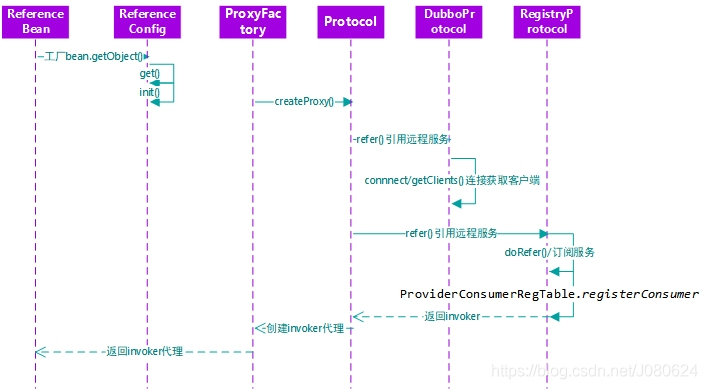
⑥ 时序图
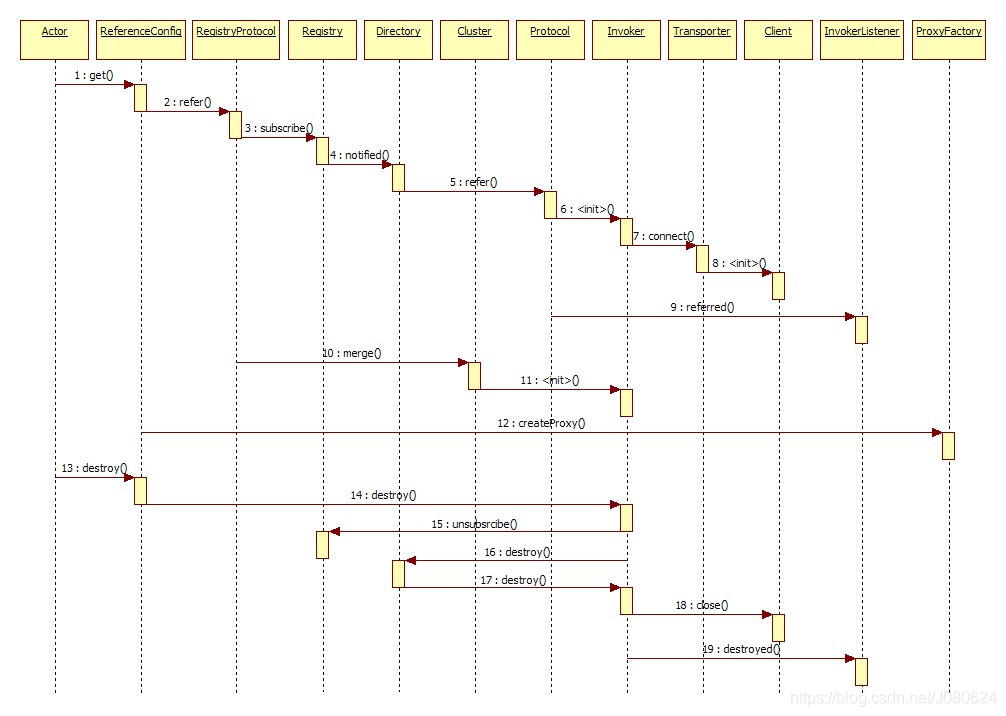
【7】Dubbo中的服务调用
如下图所示:
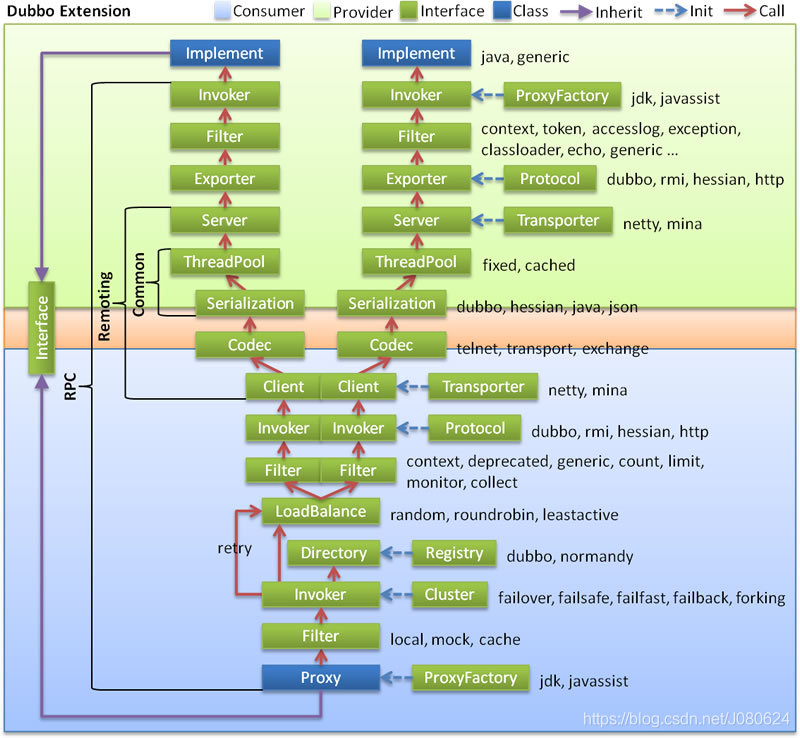
其实Dubbo服务调用的核心就是DubboInvoker的doInvoke方法,底层使用Netty进行通信。
实现细节参考官方文档:http://dubbo.apache.org/zh-cn/docs/dev/implementation.html。










